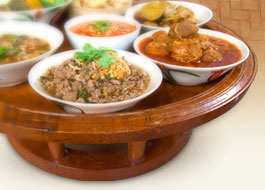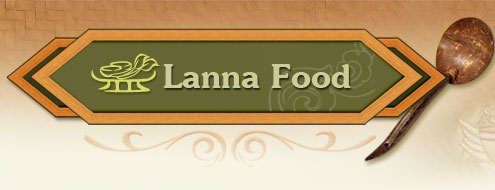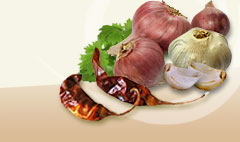Amaranth (Phak Khom) |
|
|
 | Amaranthus Tricolor Linn. |
|
| |
 | Amoranthaceae |
|
| |
 | Amaranth |
|
| |
 | Phak khom khao, phak khom chin, phak khom nam, phak khom yai, phak hom nam, phak hom phrao, phak khom bai yai (Agricultural Extension Department, 2007), watcha phuet mu, wacha phuet sum sam (Phak Phuen Ban Ahan Thai, 2005, p. 74), phak khom, phak hom. |
|
| |
 | An annual plant of three kinds: the Chinese variety, (phak hom chin) has dark green leaves with red veins. The garden variety (phak hom suan) has light green leaves with slender stems and is the most common or popular kind in Thailand. The thorny variety or phak khom nam has broad green leaves with thorny stems. All of them taste more or less the same (Phak Phuen Ban Ahan Thai, 2005, p. 74).
The information that follows is for the phak khom chin.
The plant is approximately 30-100 cm high with succulent light green stems and reddish brown at the base. Leaves are simple, alternate, rhomboidal or lanceolate, 7 cm wide, 10 cm. long, smooth or slightly hairy, with round margins, shiny black or brown (Aruni Wisetsuk, et al., 1999, p. 145).
|
|
| |
 |

Calcium, phosphorus, Vitamins A, C and betacarotin. (Phak Phuen Ban, 2005, p. 74). The young plants and leaves are served blanched with namphrik or they can be eaten with mixed vegetable soup or fried.
|

The plant is believed to stimulate the flow of breast milk in a pregnant woman (Phak Phuen Ban Ahan Thai, 2005, p. 74)(Arunee Wisetsuk, 1999, pp. 144-149) The whole plant can treat toxins of all kinds as well as hemorrhoids, itchiness and rash, sores and boils. Phak hom hat is used to treat skin rashes, scorpion stings, colds and as a diuretic. The thorny variety is a cure for bleeding, stuffy stomach and used as a diuretic. The leaves purify the blood and treat infections; the roots can be mixed with water for bathing to relieve itchiness on the skin. As a laxative for children, or pulverized to put on infected wounds and burns caused by hot water.
|
|
| |
 | All year Round |
|
| |
 |
Agricultural Extension Department. (2007). Phak Phuen Ban. Retrieved 10 June2007from http://singburi.doae.go.th/acri (in thai). Aruni Wisetsuk, et al. (1999). Phak Phuen Ban Phak Tai. Edited by Kanchana Diwiset. Nonthaburi: Project on Text Development of Traditional Thai Medicine. The Traditional Thai Medicine Institute, Foundation for the Development of Traditional Thai Medicine.(in thai). Phak Phuen Ban Ahan Thai. (2005). Bangkok: Saeng Daet. (in thai). |
|
| |
|
|




